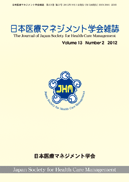Volume 18, Issue 2
Displaying 1-9 of 9 articles from this issue
- |<
- <
- 1
- >
- >|
Review Article
-
Article type: Review Article
2017Volume 18Issue 2 Pages 56-60
Published: September 01, 2017
Released on J-STAGE: July 26, 2022
Download PDF (609K)
Original Articles
-
Article type: Original Articles
2017Volume 18Issue 2 Pages 61-66
Published: September 01, 2017
Released on J-STAGE: July 26, 2022
Download PDF (728K)
Case Reports
-
Article type: Case Reports
2017Volume 18Issue 2 Pages 67-70
Published: September 01, 2017
Released on J-STAGE: July 26, 2022
Download PDF (583K) -
Article type: Case Reports
2017Volume 18Issue 2 Pages 71-74
Published: September 01, 2017
Released on J-STAGE: July 26, 2022
Download PDF (896K) -
Article type: Case Reports
2017Volume 18Issue 2 Pages 75-78
Published: September 01, 2017
Released on J-STAGE: July 26, 2022
Download PDF (528K) -
Evaluation of the support for newly graduated nurses and the support from other nurses by preceptorsArticle type: Case Reports
2017Volume 18Issue 2 Pages 79-84
Published: September 01, 2017
Released on J-STAGE: July 26, 2022
Download PDF (1146K) -
Article type: Case Reports
2017Volume 18Issue 2 Pages 85-89
Published: September 01, 2017
Released on J-STAGE: July 26, 2022
Download PDF (605K) -
Article type: Case Reports
2017Volume 18Issue 2 Pages 90-94
Published: September 01, 2017
Released on J-STAGE: July 26, 2022
Download PDF (659K)
Introductory Reports
-
Article type: Introductory Reports
2017Volume 18Issue 2 Pages 95-97
Published: September 01, 2017
Released on J-STAGE: July 26, 2022
Download PDF (656K)
- |<
- <
- 1
- >
- >|
